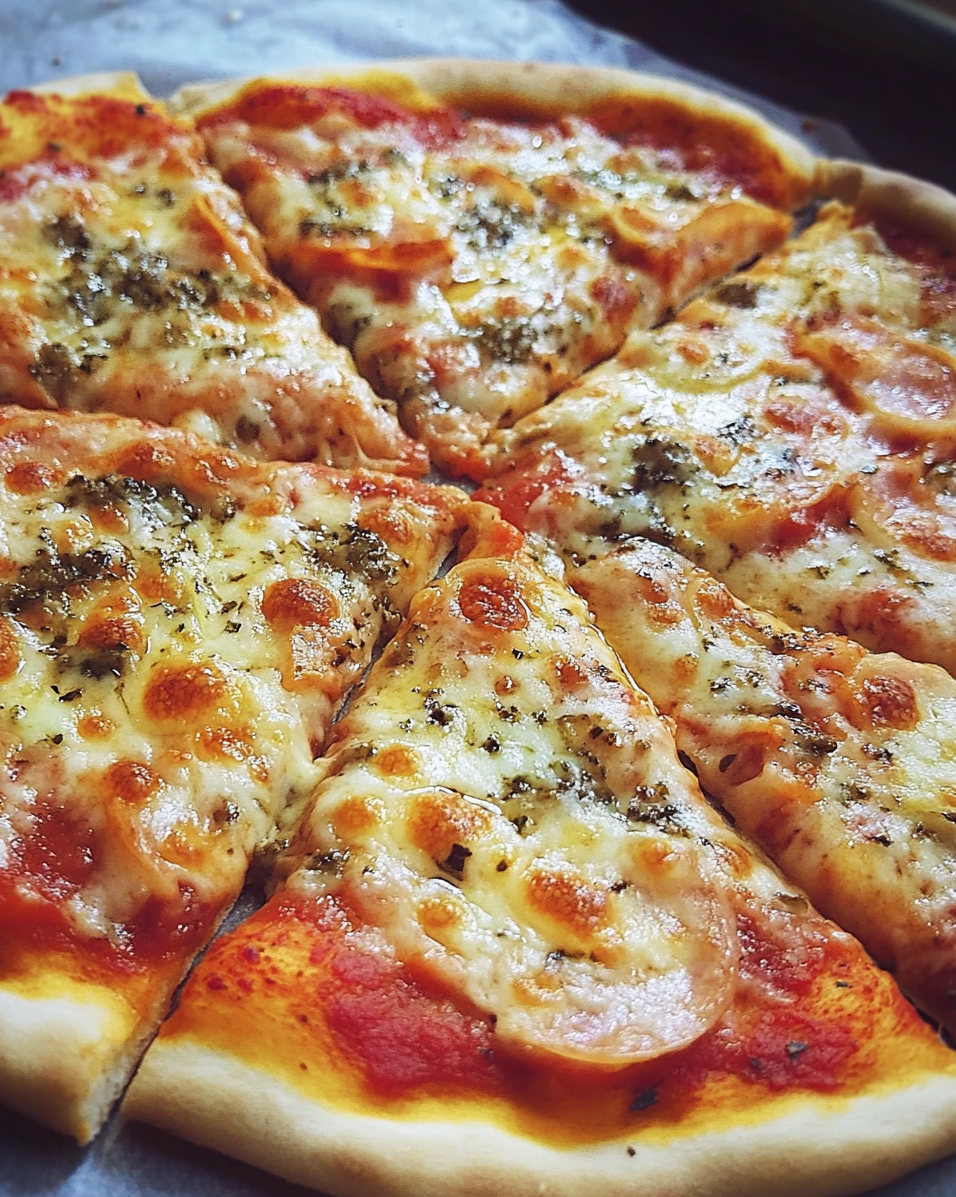This Quick and Easy Pizza Crust recipe is the perfect solution for those nights when you want homemade pizza without the hassle. The crust comes together in just minutes and bakes up crispy on the outside while remaining soft and chewy on the inside. It’s the ideal base for any toppings you love, making it versatile and crowd-pleasing.
Whether you’re hosting a pizza night with friends or just craving a slice of comfort food, this recipe delivers delicious results every time. The simplicity of the ingredients and the speed of preparation make it a go-to for busy weeknights or casual weekends. You’ll love how easy it is to create a pizza that tastes like it came from your favorite pizzeria, right in the comfort of your own kitchen.
Full Recipe:
- 1 (.25 ounce) package active dry yeast
- 1 teaspoon white sugar
- 1 cup warm water (110 degrees F/45 degrees C)
- 2 1/2 cups bread flour
- 2 tablespoons olive oil
- 1 teaspoon salt
Directions:
- Preheat your oven to 450°F (230°C). In a medium bowl, dissolve the sugar in warm water, and then add the yeast. Let it sit for about 10 minutes until the yeast is frothy.
- Stir in the flour, salt, and olive oil. Beat until smooth, then let it rest for 5 minutes.
- Turn the dough out onto a lightly floured surface and pat or roll into a round shape. Transfer to a lightly greased pizza pan or baking sheet, and top with your favorite toppings.
- Bake in the preheated oven for 15 to 20 minutes, or until the crust is golden and the cheese is bubbly.
Prep Time: 10 minutes | Cooking Time: 20 minutes | Total Time: 30 minutes
Kcal: 150 kcal | Servings: 8 servings
About the Recipe
The “Quick and Easy Pizza Crust” recipe is a fantastic option for anyone looking to enjoy homemade pizza without spending hours in the kitchen. This recipe is especially popular among busy families and individuals who appreciate the satisfaction of baking from scratch but need something that fits into their hectic schedules.
Why This Recipe Works
- Simplicity: The ingredient list is short and straightforward, consisting of pantry staples like flour, yeast, sugar, and olive oil. This means you can whip up a pizza crust even on short notice without a trip to the grocery store.
- Speed: Unlike more complex dough recipes that require extended rising times, this pizza crust is ready to bake in just 10 minutes of prep time, plus 20 minutes in the oven. This makes it an excellent choice for weeknight dinners or spontaneous pizza cravings.
- Versatility: This crust serves as a blank canvas for any type of pizza you want to create. Whether you prefer classic margherita, pepperoni, or something more adventurous like BBQ chicken or veggie supreme, this crust can handle it all.
- Texture: The recipe balances crispiness and chewiness, resulting in a crust that’s golden on the outside but soft and slightly chewy on the inside. This texture is ideal for supporting a variety of toppings without becoming soggy or overly dense.
Tips for Success
- Water Temperature: Make sure the water you use to activate the yeast is warm (around 110°F or 45°C). If the water is too hot, it can kill the yeast, and if it’s too cold, the yeast won’t activate properly.
- Flour: Bread flour is recommended for this recipe as it gives the crust a slightly chewier texture. However, if you don’t have bread flour on hand, all-purpose flour will work in a pinch.
- Resting the Dough: Although the recipe only calls for a 5-minute rest after mixing, allowing the dough to rest a bit longer (up to 30 minutes) can develop more flavor and make it easier to roll out.
- Baking: For an extra crispy crust, consider preheating your pizza stone or baking sheet in the oven before adding the dough. This helps the bottom of the crust cook faster, giving it a satisfying crunch.
Customization Ideas
- Herbed Crust: For an extra burst of flavor, mix dried herbs like oregano, basil, or garlic powder into the dough.
- Stuffed Crust: If you’re feeling indulgent, you can stuff the edges of the crust with cheese before baking.
- Whole Wheat Option: To make the crust a bit healthier, you can substitute up to half of the bread flour with whole wheat flour.
Serving Suggestions
This pizza crust pairs perfectly with a variety of toppings and side dishes. Here are a few ideas to complete your pizza night:
- Toppings: Consider classic toppings like mozzarella, tomato sauce, pepperoni, and fresh basil. For a gourmet touch, try prosciutto, arugula, and shaved parmesan.
- Side Dishes: Serve your pizza with a fresh salad, such as a Caesar salad or a mixed greens salad with balsamic vinaigrette. Garlic bread or breadsticks are also great accompaniments.
- Beverage Pairing: A crisp, cold beer or a glass of red wine, like Chianti or Sangiovese, complements the flavors of the pizza beautifully.
Origins of Pizza Crust
The pizza crust is arguably the most important element of a pizza, forming the base that supports all the delicious toppings. The origins of pizza can be traced back to ancient civilizations, where flatbreads were topped with various ingredients and baked. However, modern pizza, as we know it today, originated in Naples, Italy, in the 18th century. The classic Neapolitan pizza is renowned for its thin, soft crust with a slightly charred edge, achieved by cooking in a wood-fired oven at very high temperatures.
The recipe you’re featuring, however, offers a more accessible version of the pizza crust that can be made quickly in a conventional home oven, making it possible for everyone to enjoy a taste of Italy without needing special equipment or advanced culinary skills.
The Role of Yeast in Pizza Dough
Yeast is a key ingredient in pizza dough as it causes the dough to rise and develop a light, airy structure. In this recipe, active dry yeast is used, which needs to be activated in warm water with a bit of sugar. The yeast ferments the sugars in the dough, producing carbon dioxide gas that gets trapped in the dough’s gluten network, causing it to rise.
The short rise time in this recipe makes it a quick option for pizza night, but the yeast still imparts a slight tanginess and a pleasant aroma to the crust. The texture achieved with this method is a perfect balance between crispy and chewy, making it ideal for a wide range of pizza styles.
Nutrition and Dietary Information
This pizza crust recipe is not only quick and delicious but also relatively light in calories. With approximately 150 calories per serving, it’s a great option for those who are mindful of their calorie intake but still want to indulge in a comforting meal.
For those with dietary restrictions, this recipe can be adapted to meet various needs:
- Gluten-Free: Substitute the bread flour with a gluten-free all-purpose flour blend. You may need to add a binding agent like xanthan gum to mimic the elasticity that gluten provides.
- Vegan: This recipe is naturally vegan, as it doesn’t include any animal products. Simply top with your favorite plant-based ingredients for a delicious vegan pizza.
- Low-Sodium: For those watching their salt intake, reduce the amount of salt in the dough, or use a salt substitute. Be mindful of the sodium content in your toppings as well.
Tips for Storing and Reusing Dough
One of the great things about this recipe is that it’s easy to prepare in advance and store for later use:
- Refrigeration: After the dough has been mixed and risen, you can store it in an airtight container in the refrigerator for up to 3 days. When ready to use, let the dough come to room temperature before rolling it out and baking.
- Freezing: For longer storage, you can freeze the dough. After the initial rise, portion the dough into desired sizes, wrap each portion tightly in plastic wrap, and place in a freezer bag. The dough can be frozen for up to 3 months. To use, thaw the dough in the refrigerator overnight and let it come to room temperature before proceeding with the recipe.
Exploring Different Pizza Styles with This Crust
While this recipe provides a basic pizza crust, it’s a versatile base that can be adapted to various pizza styles:
- Thin-Crust Pizza: For a crispier, thinner crust, roll the dough out more thinly and bake it on a preheated pizza stone or directly on the oven rack.
- Thick-Crust Pizza: For a more substantial, chewy crust, let the dough rise a second time after rolling it out, or simply roll it out to a thicker dimension. This style works particularly well with heavier toppings.
- Stuffed Crust Pizza: To create a stuffed crust, roll the edges of the dough around a string of cheese (like mozzarella) before adding your toppings. This adds an extra element of indulgence to your pizza.
Pairing Your Pizza with the Perfect Sides
To elevate your pizza night, consider pairing your homemade pizza with a selection of sides that complement the flavors:
- Salads: A fresh, crisp salad with a tangy vinaigrette is a classic pairing with pizza. Consider options like a Caesar salad, a mixed greens salad with cherry tomatoes, or a caprese salad with fresh mozzarella, tomatoes, and basil.
- Appetizers: Start your meal with some simple appetizers like garlic knots, bruschetta, or a charcuterie board featuring cured meats, cheeses, and olives.
- Dessert: For dessert, consider something light and refreshing like a lemon sorbet or a simple fruit salad. If you want to stay in the Italian theme, tiramisu or cannoli are excellent choices.
The Versatility of Pizza
Pizza is one of the most beloved foods around the world, and part of its appeal lies in its incredible versatility. This “Quick and Easy Pizza Crust” recipe can serve as a starting point for endless culinary creativity. Whether you stick to traditional toppings or explore more unconventional flavors, this crust will reliably deliver a delicious result.
Conclusion
The “Quick and Easy Pizza Crust” recipe is a true lifesaver for pizza lovers who want homemade quality without the wait. It’s a versatile, reliable recipe that you can turn to time and time again, whether you’re cooking for yourself, your family, or entertaining friends. With a few basic ingredients and minimal effort, you can create a delicious pizza that rivals anything from your local pizzeria.






